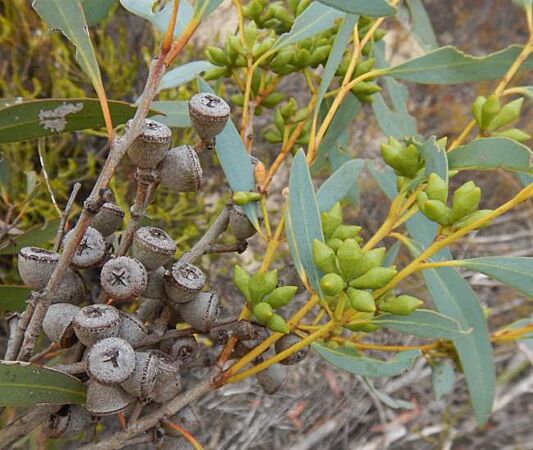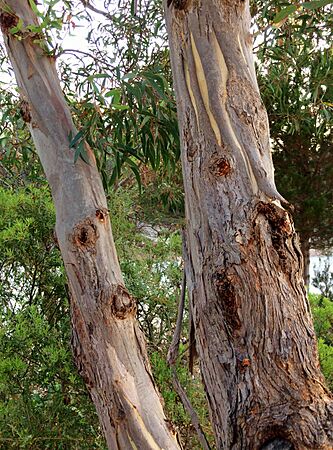Soap mallee facts for kids
Quick facts for kids Soap mallee |
|
|---|---|
 |
|
| Eucalyptus diversifolia on Kangaroo Island | |
| Scientific classification | |
| Genus: |
Eucalyptus
|
| Species: |
diversifolia
|
The Eucalyptus diversifolia, also known as the soap mallee, is a special type of tree or large bush. It grows only in certain areas along the southern coast of Australia. This plant is known for its smooth bark, long, narrow leaves, and white or creamy yellow flowers. It also produces cup-shaped fruits.
Contents
About the Soap Mallee
The soap mallee is a type of mallee, which means it's a eucalyptus plant that grows with multiple stems from a large, woody base called a lignotuber. It usually grows to be about 0.5 to 8 meters (about 1.5 to 26 feet) tall. Its bark is mostly smooth and comes in cream and grey colors.
Young soap mallee plants have leaves that are shaped like eggs and grow in pairs. These leaves are about 40 to 75 millimeters (1.5 to 3 inches) long and 10 to 25 millimeters (0.4 to 1 inch) wide. As the plant gets older, its leaves change. Adult leaves are olive-green or bluish-green on both sides and are shaped like a spear. They are about 55 to 100 millimeters (2 to 4 inches) long and 10 to 22 millimeters (0.4 to 0.9 inches) wide. These leaves grow on a small stem called a petiole, which is about 12 to 18 millimeters (0.5 to 0.7 inches) long.
The flowers of the soap mallee grow in groups of seven, nine, or eleven. These groups appear where the leaves meet the stem. Each flower bud is diamond-shaped and measures about 5 to 12 millimeters (0.2 to 0.5 inches) long. They have a cone-shaped cap called an operculum. The soap mallee usually flowers between July and September, or from December to January. Its flowers are white to cream-yellow.
After flowering, the plant produces woody, cup-shaped fruits called capsules. These fruits are about 5 to 11 millimeters (0.2 to 0.4 inches) long and 8 to 11 millimeters (0.3 to 0.4 inches) wide. Inside the fruits are smooth, shiny brown seeds that look like tiny pyramids.
How the Soap Mallee Got Its Name
The soap mallee was first officially described by a botanist named Aimé Bonpland in 1814. He wrote about it in his book, Description des Plantes Rares cultivees a Malmaison et a Navarre.
The scientific name diversifolia comes from two Latin words: diversus, meaning "different," and folium, meaning "leaf." This name refers to how the plant has different types of leaves as it grows from a young plant to an adult.
Scientists have also identified different types, or subspecies, of Eucalyptus diversifolia. In 1987, Ian Wright and Pauline Ladiges described three subspecies. Two of these are still recognized today:
- Eucalyptus diversifolia subspecies diversifolia: This type has smooth bark and cup-shaped fruits that are usually smaller than 12 millimeters (0.5 inches) across.
- Eucalyptus diversifolia subspecies hesperia: This type has a small amount of rough bark at its base. Its fruits are usually smaller than those of subspecies diversifolia.
There was also a subspecies called Eucalyptus diversifolia subspecies megacarpa. Some scientists now consider it to be the same as subspecies diversifolia. However, in the state of Victoria, it is still seen as a separate subspecies. This type has larger fruits, measuring 12 to 15 millimeters (0.5 to 0.6 inches) across.
Where Does It Grow?
The soap mallee grows in soils that come from limestone. You can often find it on exposed areas of land that stick out into the sea, like headlands.
The subspecies diversifolia is found in South Australia on the Eyre and lower Yorke Peninsulas, and on Kangaroo Island. It also grows eastward into Victoria, reaching the Cape Nelson State Park. There's even a small group of these plants growing by themselves near Aireys Inlet in Victoria. However, you won't find it in the very western part of South Australia, in an area called the Nullarbor Plain.
The subspecies hesperia grows west of the Nullarbor Plain. You can find it between towns like Eucla, Caiguna, Cocklebiddy, and Madura in Western Australia.
Why is the Soap Mallee Important?
The soap mallee is a very useful plant. It can produce a lot of biomass, which is plant material that can be used for energy. It can grow between 10 to 20 tons of biomass per hectare each year.
In farming areas, especially those where wheat is grown, the soap mallee is very helpful. It can reduce salinity in the soil, which means it helps lower the amount of salt. This is good for other plants and for the land. The trees also provide shade for farm animals, act as a windbreak to protect crops and soil from strong winds, and help reduce erosion (when soil is washed away by wind or water).
Images for kids
- Features of ''Eucalyptus diversifolia''






